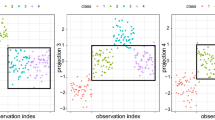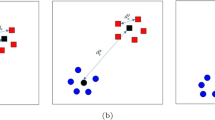Abstract
Linear boundary discriminant analysis (LBDA) shows good feature extraction performance in the classification problem. However, LBDA suffers from small sample size (SSS) problem and the computation time of it increases exponentially for datasets that are not sufficiently large compared with the number of features. To release these problems, we reformulate LBDA using QR decomposition, and this results in both reducing computation time and resolving SSS problem while classification performance is maintained.



Similar content being viewed by others
Notes
Other kinds of pattern separation methods can also be used as a data preprocessing for LBDA.
We can control the number of boundary pattern, n (B), by controlling the number of nearest neighbors k. In most experimental results, the best performance of classification is obtained by small number of k.
References
Fukunaga K (1990) Introduction to statistical pattern recognition. Academic Press, San Diego
Loog M, Duin RPW (2004) Linear dimensionality reduction via a heteroscedastic extension of lda: the chernoff criterion. IEEE Trans Pattern Anal Mach Intell 26(6):732–739
Na JH, Park MS, Choi JY (2010) Linear boundary discriminant analysis. Pattern Recogn 43:929–936
Swets DL, Weng J (1996) Using discriminant eigenfeatures for image retrieval. IEEE Trans Pattern Anal Mach Intell 18(8):831–836
Belhumeur PN, Hespanha JP, Kriegman DJ (1997) Eigenfaces vs fisherfaces: recognition using class specific linear projection. IEEE Trans Pattern Anal Mach Intell 19(7):711–720
Zhao W, Chellappa R, Phillips P (1999) Subspace linear discriminant analysis for face recognition. Technical Report CAR-TR-914, Center for Automation Research, University of Maryland, Baltimore
Golub GH, Load CFV (1996) Matrix computations. The Johns Hopkins University Press, 3rd edn. Baltimore, USA
Friedman JH (1989) Regularized discriminant analysis. J Am Stat Assoc 84:165–175
Ye J, Li Q (2004) LDA/QR: an efficient and effective dimension reduction algorithm and its theoretical foundation. Pattern Recogn 37(4):851–854
Ye J, Li Q, Xiong Q, Park H, Janardan R, Kumar V (2005) IDR/QR: an incremental dimension reduction algorithm via QR decomposition. IEEE Trans Knowl Data Eng 17(9):1208–1222
Na JH, Yun SM, Kim M, Choi JY (2008) Relevant pattern selection for subspace learning. In: International conference on pattern recognition, pp 1–4
Newman DJ, Hettich S, Blake CL, Merz CJ (1998) UCI repository of machine learning databases. http://archive.ics.uci.edu/ml/
Li T, Zhu S, Ogihara M (2003) Using discriminant analysis for multi-class classification. In: IEEE international conference on data mining, pp 589–592
Allwein EL, Schapire RE, Singer Y (2000) Reducing multiclass to binary: a unifying for margin classifiers. J Mach Learn Res 1:113–141
Chapelle C, Vapnik V, Bousquet O, Mukherjee S (2002) Choosing multiple parameters for support vector machines. Mach Learn 46(1):131–159
Diaco A, DiCarlo J, Santos J (2000) Stanford medical students database. http://scien.stanford.edu/pages/labsite/2001/ee368/projects2001/dropbox/project16
Yang B, Chen S, Wu X (2011) A structurally motivated framework for discriminant analysis. Pattern Anal Appl 14(4):349–367. doi:10.1007/s10044-011-0228-8
Chougdali K, Jedra M, Zahid N (2010) Kernel relevance weighted discriminant analysis for face recognition. Pattern Anal Appl 13(2):213–221
Acknowledgments
This work was partly supported by the Global Frontier R&D Program on Human-centered Interaction for Coexistence funded by the National Research Foundation of Korea grant funded by the Korean Government (MEST) (NRF-M1AXA003-2011-0031425).
Author information
Authors and Affiliations
Corresponding author
Rights and permissions
About this article
Cite this article
Na, J.H., Park, M.S., Kang, WS. et al. Linear boundary discriminant analysis based on QR decomposition. Pattern Anal Applic 17, 105–112 (2014). https://doi.org/10.1007/s10044-012-0285-7
Received:
Accepted:
Published:
Issue Date:
DOI: https://doi.org/10.1007/s10044-012-0285-7




